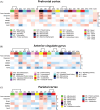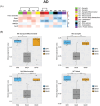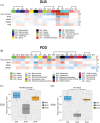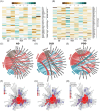Proteomic signatures of Alzheimer's disease and Lewy body dementias: A comparative analysis
- PMID: 39711511
- PMCID: PMC11780320
- DOI: 10.1002/alz.14375
Proteomic signatures of Alzheimer's disease and Lewy body dementias: A comparative analysis
Abstract
Introduction: We aimed to identify unique proteomic signatures of Alzheimer's disease (AD), dementia with Lewy bodies (DLB), and Parkinson's disease dementia (PDD).
Methods: We conducted a comparative proteomic analysis of 33 post mortem brains from AD, DLB, and PDD individuals without dementia focusing on prefrontal, cingulate, and parietal cortices, using weighted gene co-expression network analyses with differential enrichment analysis.
Results: Network modules revealed hub proteins common to all dementias. Lewy body dementias differed from AD by reduced levels of the autophagy protein p62 (SQSTM1), whereas DLB was distinguished from both AD and PDD by altered TRIM33 and cysteine/glutamate transporter (SLC7A11) across brain regions. An increase in mitochondrial and synaptic proteins was related to better cognition whereas enrichment in the extracellular matrix, complement system, and autophagy proteins was associated with greater cognitive impairment.
Discussion: Our study offers valuable insights into the network-based biomarker characterization of molecular signatures of AD, DLB, and PDD.
Highlights: Reduced levels of the autophagy protein p62 (SQSTM1) differentiated Lewy body dementias from Alzheimer's disease (AD) across multiple brain regions. Dementia with Lewy bodies (DLB) was distinguished from both AD and Parkinson's disease dementia (PDD) by altered TRIM33 and cysteine/glutamate transporter (SLC7A11) levels across brain regions. Key mitochondrial oxidative phosphorylation proteins (e.g., COX7A2, TOMM40L, NDUFV1), and synaptic proteins (e.g., GABRB3, GABRB2, GLUA3, GLUA4, SNAP47, dynamin1) were more abundant in preserved cognitive states. Extracellular matrix proteins and members of the complement system (decorin, biglycan, C4A, C4B) showed a strong positive correlation with cognitive decline.
Keywords: Alzheimer's disease; Lewy body dementias; cognitive impairment; co‐expression network analysis; mass spectrometry; synaptic proteins.
© 2024 The Author(s). Alzheimer's & Dementia published by Wiley Periodicals LLC on behalf of Alzheimer's Association.
Conflict of interest statement
All authors declare that they have no conflicts of interest. Author disclosures are available in the supporting information.
Figures







Similar articles
-
Network proteomics of the Lewy body dementia brain reveals presynaptic signatures distinct from Alzheimer's disease.Mol Neurodegener. 2024 Aug 6;19(1):60. doi: 10.1186/s13024-024-00749-1. Mol Neurodegener. 2024. PMID: 39107789 Free PMC article.
-
Assessment of ZnT3 and PSD95 protein levels in Lewy body dementias and Alzheimer's disease: association with cognitive impairment.Neurobiol Aging. 2014 Dec;35(12):2836-2844. doi: 10.1016/j.neurobiolaging.2014.06.015. Epub 2014 Jun 17. Neurobiol Aging. 2014. PMID: 25104558
-
An iTRAQ-based proteomic analysis reveals dysregulation of neocortical synaptopodin in Lewy body dementias.Mol Brain. 2017 Aug 11;10(1):36. doi: 10.1186/s13041-017-0316-9. Mol Brain. 2017. PMID: 28800743 Free PMC article.
-
Dementia with Lewy bodies and Parkinson's disease-dementia: current concepts and controversies.J Neural Transm (Vienna). 2018 Apr;125(4):615-650. doi: 10.1007/s00702-017-1821-9. Epub 2017 Dec 8. J Neural Transm (Vienna). 2018. PMID: 29222591 Review.
-
Prevalence and clinical associations of tau in Lewy body dementias: A systematic review and meta-analysis.Parkinsonism Relat Disord. 2020 Nov;80:184-193. doi: 10.1016/j.parkreldis.2020.09.030. Epub 2020 Sep 23. Parkinsonism Relat Disord. 2020. PMID: 33260030
Cited by
-
Comorbid Pathologies and Their Impact on Dementia with Lewy Bodies-Current View.Int J Mol Sci. 2025 Aug 8;26(16):7674. doi: 10.3390/ijms26167674. Int J Mol Sci. 2025. PMID: 40868991 Free PMC article. Review.
-
Synapse vulnerability and resilience across the clinical spectrum of dementias.Nat Rev Neurol. 2025 Jul;21(7):353-369. doi: 10.1038/s41582-025-01094-7. Epub 2025 May 22. Nat Rev Neurol. 2025. PMID: 40404832 Review.
-
Ubiquitin-Proteasome System Dysregulation in Alzheimer's Disease Impacts Protein Abundance.bioRxiv [Preprint]. 2025 May 29:2025.05.29.656728. doi: 10.1101/2025.05.29.656728. bioRxiv. 2025. PMID: 40501941 Free PMC article. Preprint.
References
-
- Dorsey ER, Bloem BR. The Parkinson pandemic‐a call to action. JAMA Neurol. 2018;75:9‐10. - PubMed
-
- van Dyck CH, Swanson CJ, Aisen P, et al. Lecanemab in early Alzheimer's disease. N Engl J Med. 2023;388:9‐21. - PubMed
-
- Mead S, Fox NC. Lecanemab slows Alzheimer's disease: hope and challenges. Lancet Neurol. 2023;22:106‐108. - PubMed
Publication types
MeSH terms
Substances
Grants and funding
LinkOut - more resources
Full Text Sources
Medical
Miscellaneous

